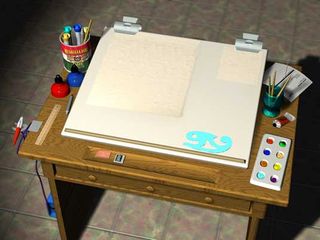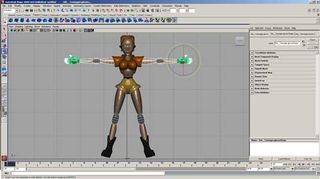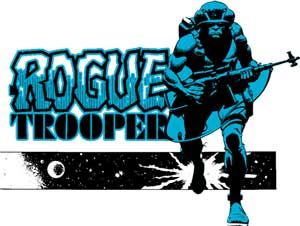15 reasons to learn 3D
Lance Evans highlights why you should get on board with this exciting discipline, in the sixth in our HP-sponsored series.
As luck would have it, I was a small kid growing up on Long Island, NY. Just a couple of miles down the road was New York Institute of Technology, which had something called a “computer graphics lab”. Pretty much first of its kind. We took a school trip to go see it in the 1970s, and while I can't say I remember much of it, I've always wondered if the seed was planted in my young mind at the time. (PS: the guys running it later became the founders of places like Pixar, Silicon Graphics, Dreamworks and more.)
Since those primordial days of computer graphics and 3D, things have changed. In just the last half decade 3D tools have found their way into far more areas of our work life than anyone would have imagined.
Let's take a look at the various projects and industries that use 3D tools, and see how learning that one set of tools (albeit in multiple software packages), can set you up to find work in many markets.
01. Illustration

There are many fine ways of doing illustration work. But as the years have rolled on, 3D tools have begun to take over large swathes of the illustrative market.
There are many good reasons: the photo-realistic qualities of the results are outstanding, but also the ability to do your work and make client changes without killing another day.
Any 3D can be pushed into service for illustrative work. Maya is popular, although certainly overkill for the job. The open source Blender could be an ideal and very robust tool for this work, and the price is right (free!).
02. Animation
Like illustration work, animation existed years before 3D showed up. Cell animation is still done today. But for the most part, all the major shops have moved over to 3D production, so if you want animation, that is largely the way to go.
Get the Creative Bloq Newsletter
Daily design news, reviews, how-tos and more, as picked by the editors.
Most 3D applications include at least some animation capabilities, and many have extensive tools. Choice depends on your needs.
03. Multimedia
This term can be a bit confusing as multimedia has so many applications. It can mean something as commonplace as the web, with text, photos and maybe some video. There are also multimedia ebooks, also referred to as “enhanced ebooks”. Some use the term to describe live immersive events and shows.
Whichever way one uses the term, many of these use 3D in various forms to dress up the high end of the presentations.
04. Game design
Sure, there is casual 2D-type game design. But you wouldn't want to go into an industry knowing you have an advancement cap from the start. Learn 3D, you will certainly need it here if doing art or animation. Maya and 3ds Max are leaders in this area, but others are used.
05. Pre-visuals
This is a term generally used in the film industry. It's that twilight zone of production in between the storyboards, and actually shooting the film. The bigger shops have entire previs departments with very talented folks that use generous amounts of 2D and 3D to bring the story alive. Animatics would be considered the low end of this art, and the high end can sometimes look like finished production.
In fact every now and again you may catch an ad on TV that is a little rough and weeks later you notice it was replaced. Odds are you saw the commercial's previs first, because the final wasn't complete in time for the already purchased timeslots. Stuff happens!
Any program can be used here, though Electricimage used to be a popular one because of its fast rendering speeds.
06. Special effects

We all know what this is, and so much of it is done in 3D. As the years have clicked on more and more of the pedestrian effects are able to be done convincingly in 2D, say in After Effects with exotic plugins. But 3D still leads the way here, and is always breaking new ground.
I seriously doubt anyone gets hired in this market without knowing some 3D, unless you are a strictly a compositor, and very talented at that. Maya, 3ds Max and Houdini are known for their effects capabilities, but others like Lightwave, Cinema4D and Electricimage have been used by many shops.
07. Broadcast and motion graphics
Here is a niche that require good understanding of 2D and 3D, as well as a good amount of broadcast-centric tools that are less widely known. The ability to do fast turn-around is crucial.
This market produces openings, credits, those cool 3D fly-through weather scenes on the news, and a lot more.
08. Character animation
This is another niche market, and one that over the years has attracted a tremendous amount of interest. It's what made so many your folks decide to go into 3D in the first place, the holy grail of creating a believable CG character.
Alas, most fell by the wayside because even with the latest software, good character stuff just ain't that easy. Watching someone who really knows this craft is just jaw-drapping. Maya and Lightwave are generally popular for character work, but plenty have used 3DS Max and Cinima4D and others as well.
09. Information design
This is a sector of the design and graphic arts markets that have been around a long time, but 3D tools have helped transform and revitalize what can be done.
Folks in this arena take what could be very dreary information, and not only make it more easily digestible, but even fun to view. The markets for this work can be print media, and it can cross over to the broadcast market.
10. Corporate communications
This market isn't as boring today as it once was thought to be. There are large numbers of companies that have seen the light and value of bringing as much as they can in-hour. Sometimes this can be for better or worse, but that's best left for another discussion. Today's corporate communications can involve all the mundane, but also 3D, video, photography, and even animation creation.
The nice thing about this market is that you need not live in any particular geographic media hub to find such a position.
11. Product & industrial design
This is a no brainer today. All industrial design and product design is done on computer aided design (CAD) systems and has been for years.
If this is your interest, take a look at some of the popular software packages like FormZ, Ehino 3D, AutoCAD, and Solidworks.
12. Architectural design & previz

These are actually two different markets that I'm throwing together. First is the architectural previsuals for selling the designs of a building. Often this is done not by the architect who designed the project, but by a 3D artist.
3DS Max is the popular package for this work, but it can be done in other packages too. Actual architectural work is done in hardcore CAD programs like AutoCAD.
13. 3D printing
This is a new and fast growing arena that's becoming mainstream. Many years ago Steve Jobs predicted everyone would have a laser printer on their desks, and that came true, more or less. He later predicted we would all have 3D printers on our desks. Time will tell.
But in the meantime companies like Shapeways is offering affordable 3D printing services to the masses. Okay, the geeky masses, but you get the idea. Where it all leads will certainly be fascinating!
14. Interior design
These days interior design has so many computer aided tools: I know many an artsy designer who is overwhelmed. There are many DIY type of 3D tools for creating sample rooms, and even for redoing existing rooms. Some really interesting incarnations of this exist as new apps on the iOS or Android stores.
Interior previsuals on the high end are done by the same folk that do architectural previs work. Again, 3ds Max is the elephant in the room for this work.
15. Digital fine art sculpture
I have a friend that was a traditional sculptor - clay, stone, etc - and some years back moved over to 'sculpting' in 3D. He was an early experimenter with output methods, and was written up all over the fine art mags and included in the Whitney Biennials. Another with similar background went digital and was later hired by the US Mint to help produce US currency. There is a market here for the truly talented!
Bonus reason: it's just so cool!

It really is. What other art form allows you to bring to it so many other disciplines and art forms? You get to design, to model, to paint/texture map, and then play photographer and light it all. Then play director and cinematographer when you animate.
These are not things to be learned overnight, and don't believe any of the hype about how easy some software is, all 3D is a kludge. But oh, how it is worth it!
Win a trip to Los Angeles!

Masters of CG is a competition for EU residents that offers the one-in-a-lifetime chance to work with one of 2000AD's most iconic characters: Rogue Trooper.
We invite you to form a team (of up to four participants) and tackle as many of our four categories as you wish - Title Sequence, Main Shots, Film Poster or Idents. For full details of how to enter and to get your Competition Information Pack, head to the Masters of CG website now.
Enter the competition today!

Thank you for reading 5 articles this month* Join now for unlimited access
Enjoy your first month for just £1 / $1 / €1
*Read 5 free articles per month without a subscription

Join now for unlimited access
Try first month for just £1 / $1 / €1
The Creative Bloq team is made up of a group of design fans, and has changed and evolved since Creative Bloq began back in 2012. The current website team consists of eight full-time members of staff: Editor Georgia Coggan, Deputy Editor Rosie Hilder, Ecommerce Editor Beren Neale, Senior News Editor Daniel Piper, Editor, Digital Art and 3D Ian Dean, Tech Reviews Editor Erlingur Einarsson and Ecommerce Writer Beth Nicholls and Staff Writer Natalie Fear, as well as a roster of freelancers from around the world. The 3D World and ImagineFX magazine teams also pitch in, ensuring that content from 3D World and ImagineFX is represented on Creative Bloq.
